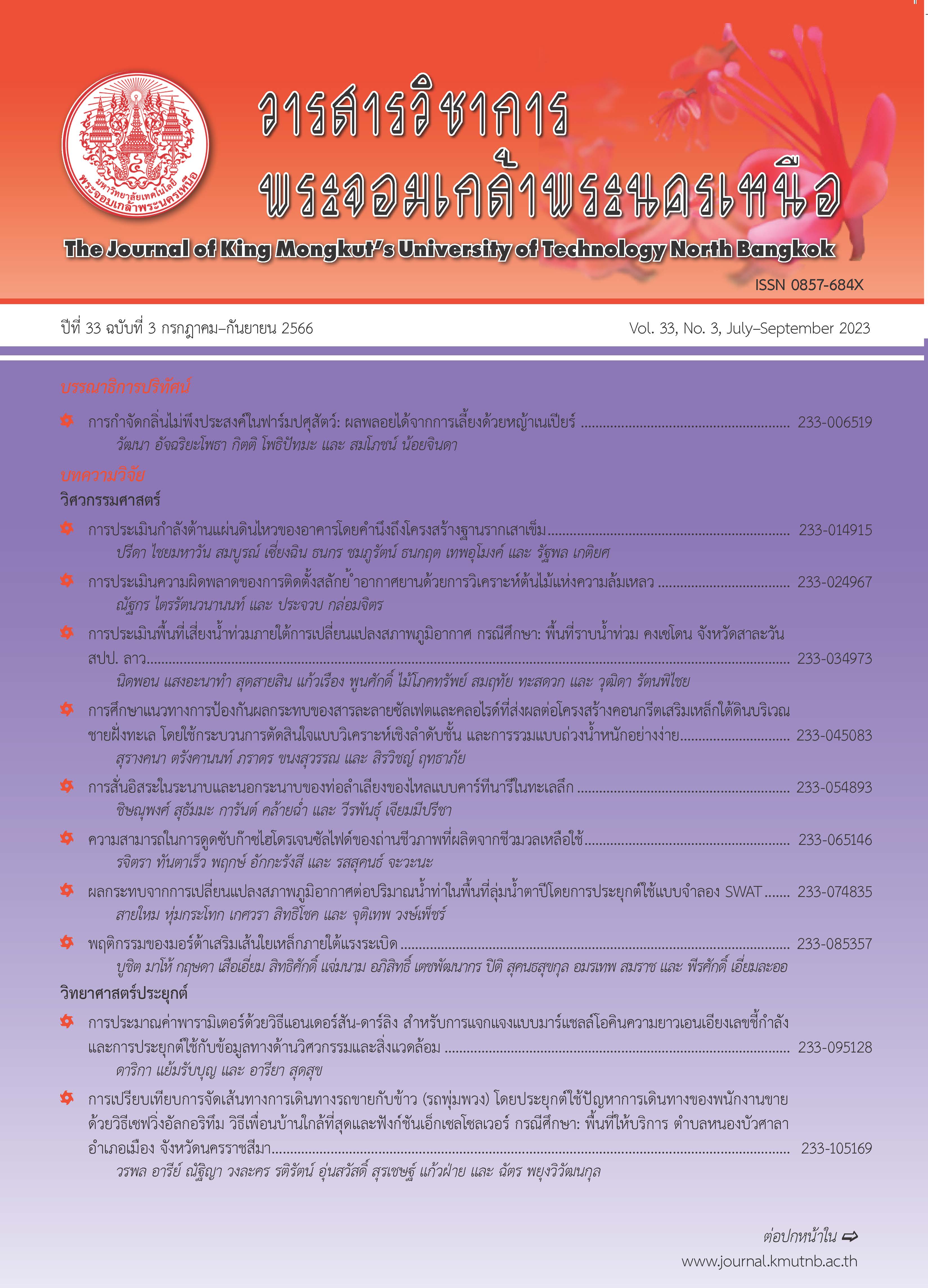แบบจำลองทางคณิตศาสตร์พลวัตเครื่องปฏิกรณ์ถ่านกัมมันต์เม็ดคงที่การไหลหมุนเวียนสำหรับบำบัดน้ำเสียชุมชน
Main Article Content
บทคัดย่อ
การวิจัยในครั้งนี้มีวัตถุประสงค์เพื่อพัฒนาแบบจำลองพลวัตเครื่องปฏิกรณ์ปลั๊กการไหลแบบหมุนเวียน (Recirculation Plug-Flow Reactor; RPFR) และแบบจำลองพลวัตเครื่องถังกวนผสมหมุนเวียน (Recirculation Completely-mixed Stirred Tank Reactor; RCSTR) ของระบบบำบัดน้ำเสียแบบถ่านกัมมันต์เม็ดคงที่การไหลหมุนเวียน (Recirculation Static Granular Activated Carbon Bed Reactor; RSGBR-GAC) มีทิศทางการไหลตั้งฉากกับถังปฏิกรณ์ทรงกระบอกตามแนวนอน มีความกว้างของชั้นกรองประมาณ 0.10 เมตร มีความลึกของชั้นกรองประมาณ เท่ากับ 0.09 เมตร และความของท่อเท่ากับ 1.80 เมตร บรรจุถ่านกัมมันต์แบบเม็ด 12.6 กิโลกรัม จากการศึกษาที่อัตราส่วนความกว้าง : ความลึก (<1 : 4) พบว่า ค่าความเหมาะสมอัตราส่วนการหมุนเวียน (QR/Qin = R) เท่ากับ 936 ใช้ปริมาตรของถังปฏิกรณ์ (Volume; V) เท่ากับ 0.014 เมตร3 เวลาหมุนเวียน (Hydraulic Recirculation Time; HReT) ที่ 1 ชั่วโมง มีประสิทธิภาพสูงสุดกำจัดค่า BOD และ NH3 (Removal BOD and NH3 Efficiency) ได้ถึง 87.40 ± 2.42% และ 62.76 ± 2.69% ในการบำบัดน้ำเสียชุมชน และจากแบบจำลองความถูกต้องและความแม่นยำพบว่า เกิดปฏิกิริยาอันดับ 2 ของแบบจำลองพลวัตเครื่องถังกวนผสมหมุนเวียน (Recirculation Completely-mixed Stirred Tank Rreactor; RCSTR) มีค่าสัมประสิทธิ์ของการย่อยสลายเชิงปริมาตรฺ kBOD2ndRCSTR และ kNH32ndRCSTR เท่ากับ 2.044 1/วัน และ 7.63 1/วัน
Article Details

อนุญาตภายใต้เงื่อนไข Creative Commons Attribution-NonCommercial-NoDerivatives 4.0 International License.
บทความที่ลงตีพิมพ์เป็นข้อคิดเห็นของผู้เขียนเท่านั้น
ผู้เขียนจะต้องเป็นผู้รับผิดชอบต่อผลทางกฎหมายใดๆ ที่อาจเกิดขึ้นจากบทความนั้น
เอกสารอ้างอิง
R. Suksomboon and C. Junsiri, “The performance of moving fluidized bed bioreactor-granular activated carbon, MFBBR- GAC,” Prawarun Agriculture Journal, vol. 15, no 1, pp. 238–247, 2018 (in Thai).
R. Suksomboon, C. Junsiri, W. Saikaew, and S. Kanyakam, “Mathematical modeling of moving fluidized bed bioreactor - granular activated carbon, MFBBR- GAC domestic wastewater treatment for agricultural use,” Prawarun Agriculture Journal, vol. 16, pp. 259– 269, 2019 (in Thai).
R. Suksomboon, C. Junsiri, S. Tangjitjaroenkit, M. Moselhy, and P. Padungthon, “Mathematical models of a fluidized bed bioreactor using granular activated carbon (FBBR-GAC) for wastewater treatment,” Engineering and Applied Science Research, vol. 46, no 3, pp. 183–191, 2019.
R. Saravanane and D. V. S. Murthy, “Application of anaerobic fluidized bed reactors in wastewater treatment,” A review, vol. 11, no. 2, pp. 97–117, 2000.
D. Mowla and M. Ahmadi. “Theoretical and experimental investigation of biodegradation of hydrocarbon polluted water in a three phase fluidized-bed bioreactor with pvc biofilm support,” Biochemical Engineering Journal, vol. 36, no. 2, pp. 147–156, 2007.
J. H. Oh, “Performance evaluation of the pilotscale static granular bed reactor (SGBR) for industrial wastewater treatment and biofilter treating septic tank effluent using recycled rubber particles,” Doctoral dissertation, Iowa State University, USA, 2012.
P. Yu and Y. Luo, “Noval water treatment process-combined cationic ionexchange bed and degasifier in a three-phase fluidized bed,” Desalination, vol. 151, no. 2, pp. 145–152, 2002.
N. Fernandez, S. Montalvo, L. Guerrero, E. Sanchez, I. Cortes and L. Travieso. “Anaerobic fluidized bed reactor application to tropical fruit wine effluent,” Water Science and Technology, vol. 56, no. 2, pp. 33–38, 2007.
R. Sowmeyan and G. Swaminathan. “Evaluation of inverse anaerobic fluidized bed reactor for treating high strength organic wastewater,” Bioresource Technology, vol. 99, no. 9, pp. 3877–3880, 2008.
S. R. Qasim, E. M. Motley, and G. Zhu. Water Works Engineering: Planning, Design and Operation. Upper Saddle River, NJ: Prentice Hall, 2000.
W. Xing, H. Ngo, W. Guo, and N. Yang, “Enhancement of the performance of anaerobic fluidized bed bioreactors (AFBBRs) by a new starch-based flocculant,” Separation and Purification Technology, vol, 72, no. 2, pp. 140– 146, 2010.
A. Zafarzadeh, B. Bina, M. Nikaeen, H. Movahedian-Attar, and M. Hajian-nejad, “Performance of moving bed biofilm reactors forbiological nitrogen compounds removal from wastewater nitrification-denitrification process,” Journal of Environmental Health Science and Engineering, vol. 7, no. 4, pp. 353–364, 2010.
R. H. Kadlec and S. D. Wallace. Treatment Wetlands. 2nd ed. Boca Raton: CRC Press, 2009.
K. Haribabu and V. Sivasubramanian. “Treatment of wastewater in fluidized bed bioreactor using low density biosupport,” Energy Procedia, vol. 50, pp. 214–221, 2014.
APHA, AWWA, and WEF. Standard methods for the examination of water and wastewater. American Public Health Association, 1999.

